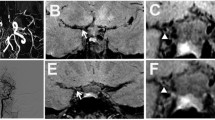Abstract
The purpose of this study was to determine the technical capacity and diagnostic accuracy of 3D time-of-flight magnetic resonance angiography (MRA) in suspected cerebral vasculitis in a retrospective analysis of MRA and digital subtraction angiography (DSA) in 14 young patients with clinical and/or radiological suspicion of cerebral vasculitis. A total of nine arteries were evaluated in each patient. Consensus review of DSA by three observers was the reference standard. The sensitivity for detecting a stenosis varied from 62 to 79% for MRA and from 76 to 94% for DSA, depending on the observer. The specificity for detecting a stenosis varied from 83 to 87% for MRA and from 83 to 97% for DSA. Using the criterion “more than two stenoses in at least two separate vascular distributions” to consider the examination as being true positive, the false-positive rates for MRA and DSA were comparable. MRA plays a role as the first angiographical examination in the diagnostic work-up of suspected cerebral vasculitis. When more than two stenoses in at least two separate vascular distributions are depicted on MRA, DSA is not expected to add a significant diagnostic contribution in a patient with suspected cerebral vasculitis. DSA remains necessary when MRA is normal or when less than three stenoses are seen.





Similar content being viewed by others
References
Pomper MG, Miller TJ, Stone JH, Tidmore WC, Hellman DB (1999) CNS vasculitis in autoimmune disease: MR imaging findings and correlation with angiography. Am J Neurorad 20:75–85
Chu CT, Gray L (1998) Diagnosis of intracranial vasculitis. J Neuropathol Exp Neurol 57:30–38
Duna GF, Calabrese LH (1995) Limitations of invasive modalities in the diagnosis of primary angiitis of the central nervous system. J Rheumatol 22:662–667
Heiserman JE, Drayer BP, Keller PJ, Fram EK (1992) Intracranial vascular stenosis and occlusion: evaluation with three-dimensional time-of-flight MR angiography. Radiology 185:667–673
Dagirmanjian A, Ross JS, Obuchowski N et al (1995) High resolution, magnetization transfer saturation, variable flip angle, time-of-flight MRA in the detection of intracranial vascular stenoses. J Comp Assist Tomogr 19:700–706
Felber S, Auer A, Schmutzhard E (2000) Magnetresonanz-Angiographie bei entzündlichen Hirnerkrankungen. Radiologe 40:1077–1089
Schlüter A, Hirsch W, Jassoy A et al (2001) MR-angiographie in der Diagnostik von Vasculitiden und beignen Angiopathien des Zentralnervensystems. Fortschr Röntgenstr 173:522–527
Harris KG, Tran DD (1994) Diagnosing intracranial vasculitis. Am J Neuroradiol 15:317–330
Wasserman BA, Stone JH, Hellmann DB, Pomper MG (2001) Reliability of normal findings on MR imaging for excluding the diagnosis of vasculitis of the central nervous system. AJR 177:455–459
Greenan TJ, Grossman RI, Goldberg HI (1992) Cerebral vasculitis: MR imaging and angiographic correlation. Radiology 182:65–72
Calabrese LH (1995) Vasculitis of the central nervous system. Rheum Dis Clin North Am 21:1059–1076
Calabrese LH, Mallek JA (1987) Primary angiitis of the central nervous system: report of 8 new cases, review of the literature and proposal for diagnostic criteria. Medicine 67:20–39
Cloft HJ, Phillips CD, Dix JE, McNulty BC, Zagardo MT, Kallmes DF (1999) Correlation of angiography and MR imaging in cerebral vasculitis. Acta Radiol 40:83–87
Oelerich M, Lentschig MG, Zunker P, Reimer P, Rummeny EJ, Schuierer G (1998) Intracranial vascular stenosis and occlusion: comparison of 3D time-of-flight and 3D phase-contrast MR angiography. Neuroradiology 40:567–573
White PM, Wardlaw JM, Lindsay KW, Sloss S, Patel DKB, Teasdale EM (2003) The non-invasive detection of intracranial aneurysms: are neuroradiologists any better than other observers? Eur Radiol 13:389–396
Hirai T, Korogi Y, Ono K, Nagano M, Maruoka K, Uemura S, Takahashi M (2002) Prospective evaluation of suspected stenoocclusive disease of the intracranial artery: combined MR angiography and CT angiography compared with digital subtraction angiography. Am J Neuroradiol 23:93–101
Acknowledgments
We are grateful to the W. Robberecht, MD, PhD, B. Dubois, MD, PhD and V. Thijs, MD, for referring the patients to the MR unit.
Author information
Authors and Affiliations
Corresponding author
Rights and permissions
About this article
Cite this article
Demaerel, P., De Ruyter, N., Maes, F. et al. Magnetic resonance angiography in suspected cerebral vasculitis. Eur Radiol 14, 1005–1012 (2004). https://doi.org/10.1007/s00330-004-2239-y
Received:
Revised:
Accepted:
Published:
Issue Date:
DOI: https://doi.org/10.1007/s00330-004-2239-y




